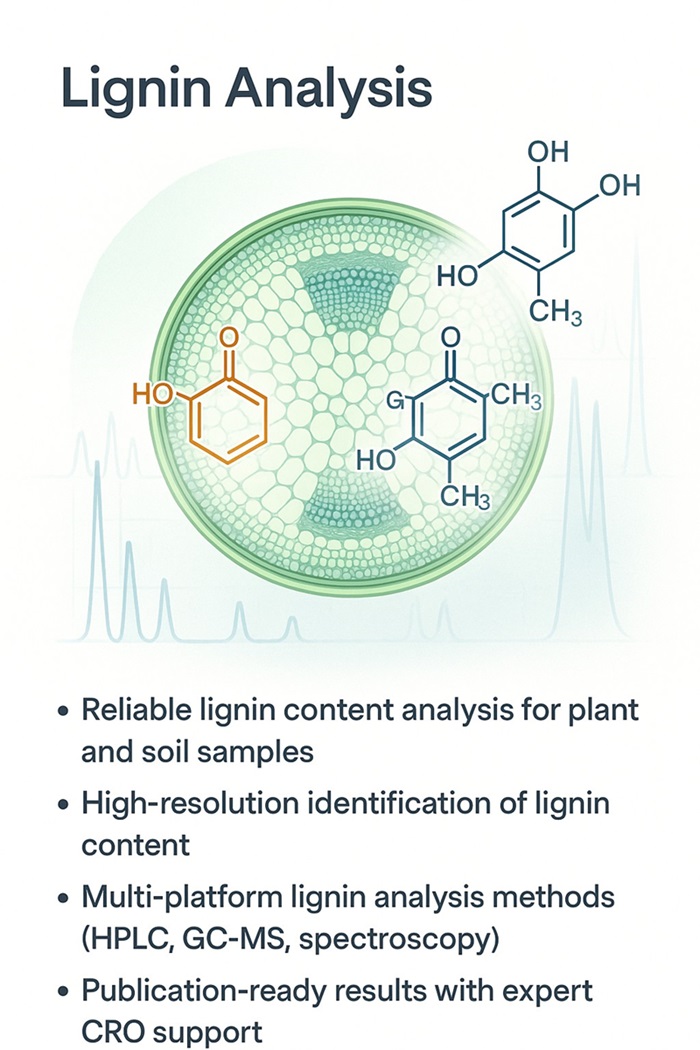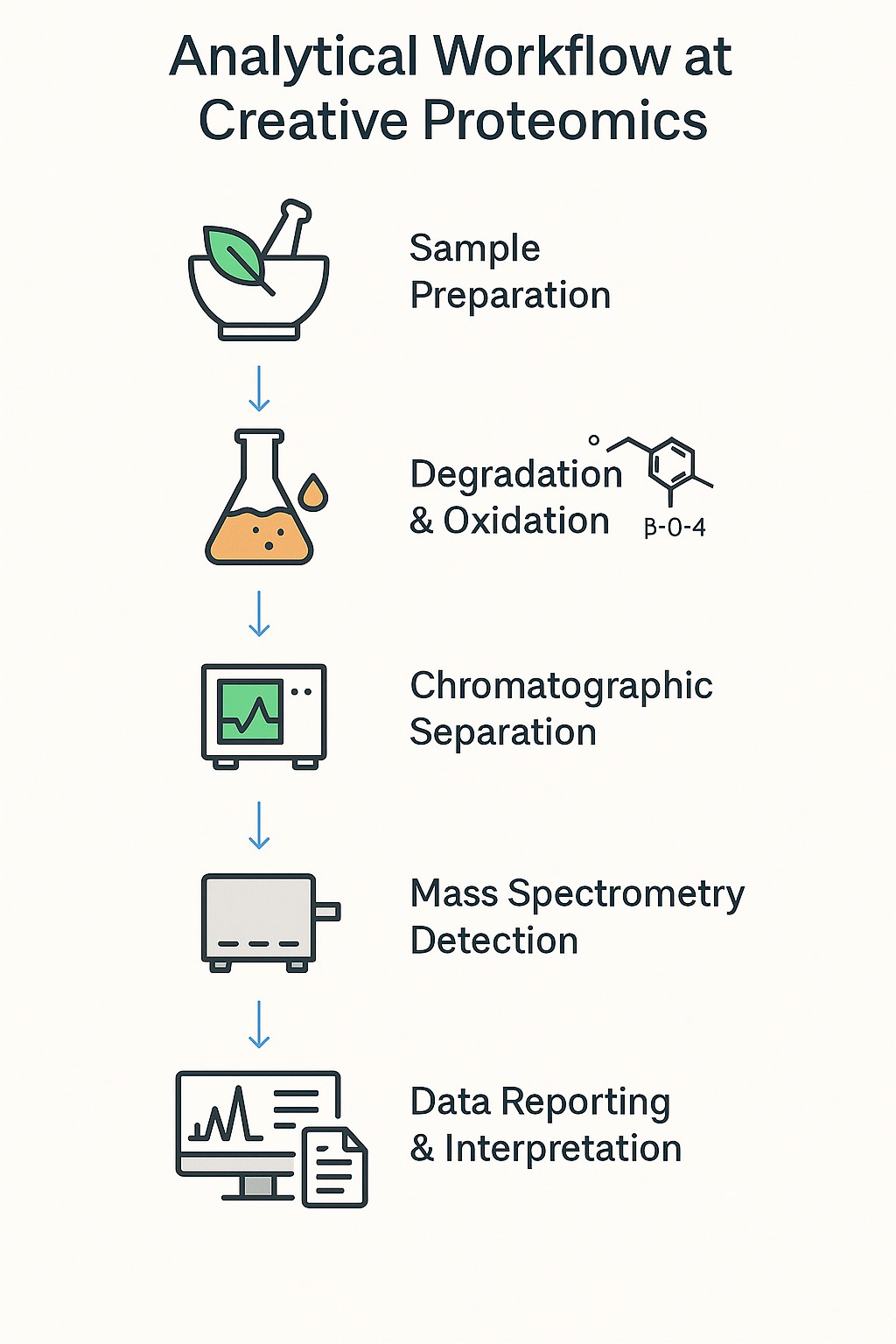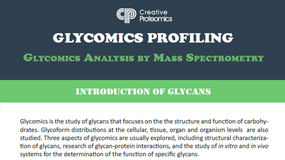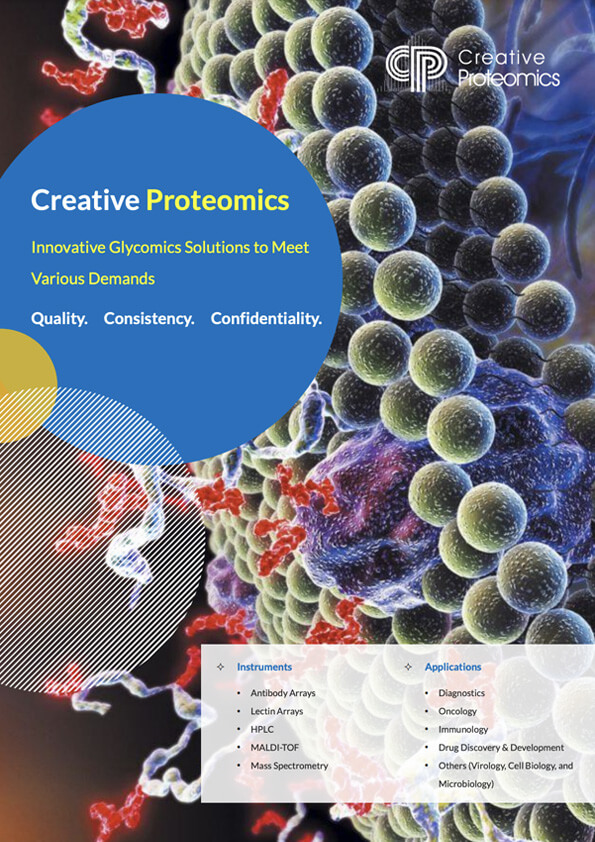Lignin Analysis Service for Plant, Soil & Biomass Research
Creative Proteomics offers comprehensive lignin content analysis services tailored for plant, soil, and biomass research. By integrating multiple lignin analysis methods—including HPLC-based monomer profiling, GC–MS phenolic fingerprinting, and classical gravimetric assays—we deliver precise determination and identification of lignin content. Our workflows are optimised for accuracy, reproducibility, and publication-ready outputs, supporting biochemistry labs, CRO partners, and academic institutions worldwide.
Service Advantages:
- Accurate lignin analysis by HPLC and GC–MS
- Flexible workflows for diverse lignin content analysis projects
- Expert interpretation and publication-ready deliverables
- Fast turnaround with dedicated technical support
Submit Your Request Now
×
- Why It Matters
- Methods
- Workflow
- Platform
- Applications
- Why Choose Us
- FAQs
- Publications
Why Lignin Analysis Matters
Lignin is the second most abundant biopolymer after cellulose, making up around 30% of plant dry matter. It reinforces the plant cell wall, supports vascular transport, and provides resistance against pathogens. However, its complex, three-dimensional structure makes lignin content analysis technically challenging.
Accurate determination of lignin content is essential across multiple research areas:
- Plant biology and breeding – Linking lignin deposition to fibre quality, seed development, and structural strength.
- Agriculture and feed science – Improving crop lodging resistance and optimising forage digestibility.
- Soil ecology and carbon cycling – Using lignin as a biomarker for organic matter turnover and microbial decomposition.
- Bioenergy and industrial research – Understanding lignin composition to enhance biomass conversion and develop renewable aromatic chemicals.
By applying modern lignin analysis methods, Creative Proteomics helps researchers overcome the limitations of traditional techniques. Our assays deliver precise insights into lignin structure and function, supporting innovation in plant genetics, ecological monitoring, and sustainable industrial applications.
Our Lignin Analysis Methods
We apply multiple lignin analysis methods, each suited to different research needs. While classical gravimetric assays remain references, our core strength is mass spectrometry-based lignin analysis for high-resolution monomer profiling and structural identification.
| Method | Principle | Strengths | Limitations | Typical Applications |
|---|---|---|---|---|
| Klason (Gravimetric) | Acid hydrolysis with 72% H₂SO₄, measure insoluble residue | Classical baseline method, widely used | Poor accuracy in softwoods/herbaceous plants; interference from proteins/minerals | Hardwood lignin quantification, reference comparisons |
| ADF Method | Acid detergent isolates lignin fractions | Suited for grasses and annual crops | Lower precision, lignin loss during prep | Forage quality, digestibility studies |
| UV/Vis, IR/NIR | Detect aromatic structures and functional groups | Rapid, non-destructive, low sample input | Requires calibration; semi-quantitative | Screening, structural profiling, method validation |
| HPLC Monomer Profiling (MS detection) | Nitrobenzene oxidation → H/G/S monomers quantified by HPLC-MS | High-resolution H/G/S ratio, sensitive, automated | Focus on monomer composition, not total lignin | Fibre research, pulp/paper industry, genetic studies |
| GC–MS Monomer Analysis | CuO or BF₃ cleavage → phenolic aldehydes, ketones, acids detected by GC–MS | High sensitivity and specificity for lignin-derived phenols | Complex sample prep and derivatization | Soil carbon cycling, biomass conversion, advanced structural analysis |
| Biomarker Phenol Ratios (V/S/C) | Measure vanillyl (V), syringyl (S), cinnamyl (C) phenols via GC–MS | Reveals lignin source (hardwood/softwood/grasses) and degradation status | Requires GC–MS and expert interpretation | Soil ecology, ecosystem carbon studies, organic matter stabilisation |
Key Point:
While gravimetric and spectroscopic assays provide general lignin quantification, Creative Proteomics specialises in HPLC-MS and GC–MS workflows, enabling detailed identification of lignin content and structural fingerprints with reproducible accuracy.
Workflow

Bioinformatics & Data Processing
| Analysis Level | Key Features | Benefits |
|---|---|---|
| Basic Analysis |
| Ensures data integrity and consistent retention time across samples |
| Advanced Analysis |
| Enhances biological interpretation, identifies sample patterns, supports publication-ready outputs |
Platform
HPLC Systems: Agilent 1260 Infinity II, Thermo UltiMate 3000
GC–MS Platforms: Agilent 7890B GC with 5977B MS, Thermo Trace 1310 GC–ISQ MS
LC–MS/MS Platforms: Thermo Orbitrap Fusion Lumos, Q Exactive HF-X, Bruker timsTOF Pro 2
Spectroscopy Tools: UV–Vis (Shimadzu UV-2600), FTIR (Bruker Tensor II)
Applications of Lignin Analysis
Lignin plays a pivotal role across multiple domains—Creative Proteomics helps translate lignin data into real-world impact.
1. Plant Biology & Crop Improvement
Lignin profiling guides crop breeding by revealing monomer ratios (H/G/S) that relate to stem strength, fiber quality, and stress resistance. Modulating lignin biosynthesis trends can improve plant performance and biomass utility.
2. Bioenergy & Biorefinery Optimization
Understanding lignin composition aids biorefinery processes. Analysing lignin content helps predict biomass conversion efficiency and supports the production of biofuels and value-added chemicals.
3. Soil Ecology & Carbon Cycling
Lignin phenol ratios (V/S/C) serve as biomarkers for soil organic matter stability and decomposition dynamics. This allows researchers to trace carbon cycling and assess soil health.
4. Industrial Materials & Green Chemistry
Lignin's high carbon content and aromatic stability make it a promising base for sustainable materials—ranging from adhesives and polymers to carbon electrodes and biodegradable composites.
5. Agricultural Applications & Soil Amendments
Modified lignin has shown strong potential in slow-release fertilisers and soil conditioners. Controlled release of nutrients enhances crop productivity and supports sustainable farming.
Why Choose Creative Proteomics
Multi-platform capability – HPLC–MS, GC–MS, and LC–MS/MS ensure accurate identification of lignin content across diverse matrices.
Expert bioinformatics – From basic QC to advanced monomer ratio profiling (H/G/S, V/S/C), we deliver reproducible insights with CV<10%.
Comprehensive reporting – Publication-ready outputs include chromatograms, spectra, quantitative tables, and expert commentary.
Cross-disciplinary support – Applications in plant biology, soil ecology, bioenergy, and industrial R&D.
Trusted global CRO partner – Supporting universities, biotech companies, and agricultural research groups worldwide.
Sample Requirements
| Sample Type | Minimum Amount | Preparation & Notes |
|---|---|---|
| Dried Plant Tissue | ≥ 1 g (oven-dried) | Air-dry or lyophilize; grind and sieve (40–80 mesh) before shipment. |
| Fresh Plant Tissue | 3–5 g (moisture still present) | Ship on dry ice; store at –80 °C; ensures integrity of volatile lignin components. |
| Soil / Biomass | 0.5–1 g (freeze-dried) | Ensure sample is homogeneous and finely ground before submission. |
| High-Lignin Biomass | 3–5 g (dry) | Use for ICP or compositional analysis; aligns with industry norms. |
FAQs
What is the difference between HPLC and GC–MS for lignin analysis?
HPLC-MS excels at separating and quantifying non-volatile lignin monomers (H, G, S) after controlled oxidation, while GC-MS is ideal for detecting volatile phenolic degradation products; both techniques complement each other and provide detailed lignin composition insight.
Can you analyze lignin in both plant and soil samples?
Yes, we tailor extraction and degradation protocols to handle diverse sample matrices—from fresh plant tissues to freeze-dried soils—ensuring accurate lignin profiling across sample types.
What type of data analysis do you provide?
We offer tiered bioinformatics: basic QC, peak detection, and integration; plus advanced monomer ratio calculations (H/G/S, V/S/C), structural annotation, and multivariate analysis such as PCA for publication-ready interpretation.
How precise and reproducible are your analyses?
Our processes include internal standards and method validation. In practice, we consistently achieve high reproducibility, with coefficient of variation under 10% in monomer quantification.
Is mass spectrometry the most accurate method for lignin content analysis?
Mass spectrometry (HPLC-MS and GC-MS) offers unmatched specificity and sensitivity for lignin monomer and phenolic profiles. While gravimetric and spectroscopic methods can estimate total lignin, only MS delivers detailed compositional breakdown and structural fingerprints.
Learn about other Q&A about proteomics technology.
Publication

- Hirakawa MP, Rodriguez A, Tran-Gyamfi MB, et al. Phenothiazines rapidly induce laccase expression and lignin-degrading properties in the white-rot fungus Phlebia radiata. Journal of Fungi. 2023.
- Gajardo HA, Morales M, Larama G, et al. Physiological, transcriptomic and metabolomic insights of three extremophyte woody species living in the multi-stress environment of the Atacama Desert. Planta. 2024.
- Matt FJ, Dietenberger MA, Weise DR. Summative and ultimate analysis of live leaves from southern US forest plants for use in fire modeling. Energy & Fuels. 2020.
- Huang J, et al. Inactivation of myeloperoxidase by benzoic acid hydrazide. Archives of Biochemistry and Biophysics. 2015.










